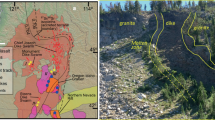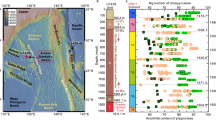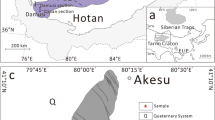Abstract
The Columbia River Basalt Group in the northwestern United States1, comprising about 230,000 cubic kilometres of rock, exhibits unusual patterns in lava distribution, geochemistry and its apparent relationship to regional tectonics. Consequently, there is little consensus on the origin of its magmas2,3,4,5,6,7,8,9,10,11,12. Here, we examine the isotopic ratios of Sr, Nd, Pb and Os and trace-element abundances in Columbia River basalts. The results suggest that most of the lava was produced when magma derived from a mantle plume assimilated continental crust in a central magma chamber system located at the boundary between the North American craton and the accreted terranes of Idaho and Oregon. Other, related basalts are the product of mixing between the mantle plume and different types of regional upper mantle. Magma was then transported over a wide region by an extensive network of dykes, a process that has been identified in other flood basalt provinces as well13. Interactions of the plume with surrounding upper mantle, and of mantle-derived magmas with regional crust, provide a relatively simple6,7,9,14,15 model to explain the more unusual features of the main-phase Columbia River Basalts.
This is a preview of subscription content, access via your institution
Access options
Subscribe to this journal
Receive 12 print issues and online access
$259.00 per year
only $21.58 per issue
Buy this article
- Purchase on Springer Link
- Instant access to full article PDF
Prices may be subject to local taxes which are calculated during checkout




Similar content being viewed by others
References
Hooper, P. R. The Columbia River flood basalt province: Current status. Geophys. Monograph 100, 1–27 (1997).
Camp, V. E. & Ross, M. E. Mantle dynamics and genesis of mafic magmatism in the intermontane Pacific Northwest. J. Geophys. Res. 109 (2004) (doi:10.1029/2003JB002838).
Carlson, R. W., Lugmair, G. W. & MacDougall, J. D. Columbia River volcanism: the question of mantle heterogeneity or crustal contamination. Geochim. Cosmochim. Acta 45, 2483–2499 (1981).
Carlson, R. W. Isotopic constraints on Columbia River flood basalt genesis and the nature of the subcontinental lithospheric mantle. Geochim. Cosmochim. Acta 48, 2357–2372 (1984).
Brandon, A. D. & Goles, G. G. A Miocene subcontinental plume in the Pacific Northwest: Geochemical evidence. Earth Planet. Sci. Lett. 88, 273–283 (1988).
Geist, D. & Richards, M. A. Origin of the Columbia Plateau and Snake River Plain: Deflection of the Yellowstone plume. Geology 21, 789–792 (1993).
Camp, V. E. Mid-Miocene propagation of the Yellowstone mantle plume head beneath the Columbia River basalt source region. Geology 23, 435–438 (1995).
Hales, T. C., Abt, D. L., Humpreys, E. D. & Roering, J. J. A lithospheric instability origin for Columbia River flood basalts and Wallowa Mountains uplift in northeast Oregon. Nature 438, 842–845 (2005).
Hooper, P. R. & Hawkesworth, C. J. Isotopic and geochemical constraints on the origin and evolution of the Columbia River basalt. J. Petrol. 34, 1203–1246 (1993).
Takahashi, E., Nakajima, K. & Wright, T. L. Origin of the Columbia River basalts: Melting model of a heterogeneous plume head. Earth Planet. Sci. Lett. 162, 63–80 (1998).
Brandon, A. D., Hooper, P. R., Goles, G. G. & Lambert, R. St. J. Evaluating crustal contamination in continental basalts: The isotopic composition of the Picture Gorge Basalt of the Columbia River Basalt Group. Contrib. Mineral. Petrol. 114, 452–464 (1993).
Hooper, P. R., Camp, V. E., Reidel, S. P. & Ross, M. E. The origin of the Columbia River flood basalt province: Plume versus nonplume models. Geol. Soc. Am. Special Paper 430, 635–668 (2007).
Ernst, R. E. & Buchan, K. L. Giant radiating dyke swarms: Their use in identifying pre-Mesozoic large igneous provinces and mantle plumes. Geophys. Monograph 100, 297–333 (1997).
Jordan, B. T., Grunder, A. L., Duncan, R. A. & Deino, A. L. Geochronology of age-progressive volcanism of the Oregon high lava plains: Implications for the plume interpretation of Yellowstone. J. Geophys. Res. 109 (2004) (doi:10.1029/2003JB002776).
Christiansen, R. L., Foulger, G. R. & Evans, J. R. Upper-mantle origin of the Yellowstone hotspot. Geol. Soc. Am. Bull. 114, 1245–1256 (2002).
Brueseke, M. E., Heizler, M. T., Hart, W. K. & Mertzman, S. A. Distribution and geochronology of Oregon Plateau (U.S.A.) flood basalt volcanism: The Steens Basalt revisited. J. Volcanol. Geotherm. Res. 161, 187–214 (2007).
Reidel, S. P. et al. The Grande Ronde Basalt, Columbia River Basalt Group; Stratigraphic descriptions and correlations in Washington, Oregon, and Idaho. Geol. Soc. Am. Special Paper 239, 21–53 (1989).
Dodson, A., Kennedy, B. M. & DePaolo, D. J. Helium and neon isotopes in the Imnaha Basalt, Columbia River basalt group: Evidence for a Yellowstone plume source. Earth Planet. Sci. Lett. 150, 443–451 (1997).
Chesley, J. T. & Ruiz, J. Crust-mantle interaction in large igneous provinces: Implications from the Re–Os isotope systematics of the Columbia River flood basalts. Earth Planet. Sci. Lett. 154, 1–11 (1998).
Class, C. & Goldstein, S. L. Evolution of helium isotopes in the Earth’s mantle. Nature 436, 1107–1112 (2005).
Brandon, A. D. & Goles, G. G. Assessing subcontinental lithospheric mantle sources for basalts: Neogene volcanism in the Pacific Northwest, USA as a test case. Contrib. Mineral. Petrol. 121, 364–379 (1995).
Caprarelli, G. & Reidel, S. P. A clinopyroxene-basalt geothermobarometry perspective of Columbia Plateau (NW-USA) Miocene magmatism. Terra Nova 17, 265–277 (2005).
Durand, S. R. & Sen, G. Pre-eruption history of the Grande Ronde Formation lavas, Columbia River Basalt Group, American Northwest: Evidence from phenocrysts. Geology 32, 293–296 (2004).
Ramos, F. C., Wolff, J. A. & Tollstrup, D. L. Sr isotope disequilibrium in Columbia River flood basalts: Evidence for rapid shallow-level open-system processes. Geology 33, 457–460 (2005).
Shirey, S. B. & Walker, R. J. 187Re–187Os isotopes in geochemistry and cosmochemistry. Ann. Rev. Earth Planet. Sci. 26, 423–500 (1998).
Widom, E., Hoernle, K. A., Shirey, S. B. & Schmincke, H.-U. Os isotope systematics in the Canary Islands and Madeira: Lithospheric contamination and mantle plume signatures. J. Petrol. 40, 279–296 (1999).
Leeman, W. P., Oldow, J. S. & Hart, W. K. Lithosphere-scale thrusting in the western U.S. Cordillera as constrained by Sr and Nd isotopic transitions in Neogene volcanic rocks. Geology 20, 63–66 (1992).
Glen, J. M. G. & Ponce, D. A. Large-scale fractures related to the inception of the Yellowstone hotspot. Geology 30, 647–650 (2002).
Stracke, A., Bizimis, M. & Salters, V. J. M. Recycling oceanic crust: Quantitative constraints. Geochem. Geophys. Geosys. 4 (2003) (doi:10.1029/2001GC000223).
Fleck, R. J. Neodymium, strontium, and trace-element evidence of crustal anatexis and magma mixing in the Idaho batholith. Geol. Soc. Amer. Mem. 174, 359–373 (1990).
Acknowledgements
We thank P. R. Hooper and J. A. Johnson for discussion and permission to analyse CRBG samples, archived at WSU, collected by them and their associates; R. M. Conrey, D. M. Cornelius and C. M. Knaack for assistance in the laboratory; B. Hanan for sharing unpublished data; and S. P. Reidel, V. E. Camp and R. M. Conrey for discussion. This study was supported by National Science Foundation grants to J.A.W. and F.C.R.
Author information
Authors and Affiliations
Corresponding author
Supplementary information
Supplementary Information
Supplementary experimental data and supplementary table S1 (PDF 184 kb)
Rights and permissions
About this article
Cite this article
Wolff, J., Ramos, F., Hart, G. et al. Columbia River flood basalts from a centralized crustal magmatic system. Nature Geosci 1, 177–180 (2008). https://doi.org/10.1038/ngeo124
Received:
Accepted:
Published:
Issue Date:
DOI: https://doi.org/10.1038/ngeo124
This article is cited by
-
Mantle source lithologies for the Columbia River flood basalt province
Contributions to Mineralogy and Petrology (2023)
-
Intrusions induce global warming before continental flood basalt volcanism
Nature Geoscience (2022)
-
The life cycle of large igneous provinces
Nature Reviews Earth & Environment (2021)
-
Geochronological and isotopic records of crustal storage and assimilation in the Wolverine Creek–Conant Creek system, Heise eruptive centre, Snake River Plain
Contributions to Mineralogy and Petrology (2016)
-
Rootless cone eruption processes informed by dissected tephra deposits and conduits
Bulletin of Volcanology (2015)



